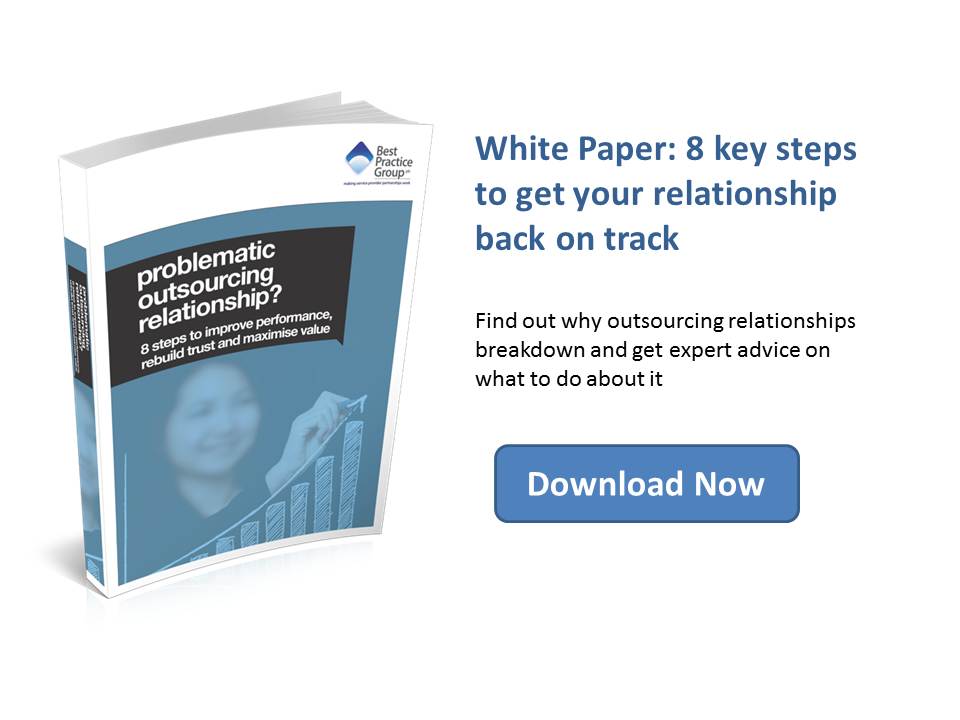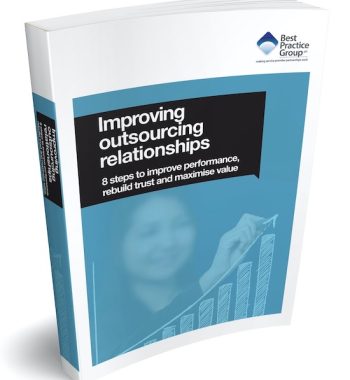
Once unquestioned as one of the UK public sector’s main service providers, Serco have had to face a number of challenges in their service delivery and management team of late. As a result, could it be said that Serco are now facing an uncertain future?
At a more generic (non-Serco) level, the question over financial stability should continue to be a catalyst for those reliant on key service providers and strategic partners for the delivery of their mission critical services. Ensuring you have ongoing visibility of likely risks to your provider’s financial stability, and having a continuous process to militate against these risks, is vital.
In this context, the recent financial situation with Serco serves as a useful case study of the types of information we usually find helpful to provide early warning signals of a provider’s likely financial position.
Background to recent events at Serco
The recent arrival of Rupert Soames as the new Group Chief Executive has led to the company embarking on a nine-month strategic review. This is not a completely surprising move in the wake of a 50% drop in their share price, leading to a halving of their market capital value.
The news that Serco was to issue its third profit warning in six months, led to a further loss in the form of Serco’s Financial Director, Andrew Jenner, who resigned just before Soames took office. Shareholders have questioned the company’s strategy; and as a result, this has been widely covered in the British media, apparently eating away at existing and potential client confidence in the organisation, as well as the confidence of other key employees within the company.
Given the recent controversies surrounding the company and the critical fall in profit that they have suffered since July 2013, two key questions arise:
- Are Serco in real financial difficulty?
- If they are, what should their private and public sector clients do about it?
As an overarching principle, however, irrespective of who your major service provider contracts are with, you should look at how to best protect your mission critical services if you suspect your provider may be having financial challenges now or in the future.
Do Serco’s problems run too deep for a management change to solve them?
Mr Soames’ arrival at the beginning of May came with the announcement that Serco is looking to raise £170 million through the sale of new shares: a sensible tactic to give the company some time and space from its apparent financial difficulties. During which time, hopefully, Soames can demonstrate that he can get matters back on track quickly – either self-sufficiently, or through a sale of one or more divisions of the organisation.
There is little doubt that Soames is hoping this series of events will show that he is actively seeking to change and reshape the company and focus on rebuilding its reputation with both staff and its key clients. But does the arrival of new blood signify a turning point for Serco, or is blaming the old guard for challenges with its direction an attempt to mask the publicly reported more serious internal problems within the organisation?
Under the leadership of former Group Chief Executive Chris Hyman, Serco reportedly suffered a number of high profile project failures, especially in regard to the contracts it held with its main public sector clients.
It was unfortunate that Serco was accused of potentially fraudulent activity within its prison van escort contract. Reports indicated that this included situations where prisoners who were no longer alive were still being charged for in the electronic tagging budget.
Our own experience of Serco is that like most service providers in this space, they have their positives and negatives, but overall, often deliver well, providing they are actively managed and performance monitored by their client in the right way.
The recent press coverage is reportedly putting Serco at risk of receiving fewer contracts from the public sector. Not only would this increase the concern for Serco’s national standing and potentially derail Soames’ strategy for the organisation, it will no doubt also harm the company’s international reputation and may affect its contracts abroad. Such an outcome is likely to leave the company vulnerable to potential takeover bids from competitors or other interested parties.
It is, therefore, crucial that Soames and his new team make significant moves – and soon –toward rebuilding relationships that have been damaged. In essence, Soames needs some quick wins. It certainly would not be sensible to simply wait for the outcome of the aforementioned nine-month review before taking some key actions, as many more client and employee relationships could be further undermined over this time. Whether they will succeed remains to be seen, but let’s hope they do for the sake of their clients already embedded with them.
How to protect yourself if your service provider runs into financial challenges
For private and public sector companies that are unsure what the future holds for their service provider, Serco’s situation can serve as a vital lesson in ensuring you undertake appropriate diligence at the outset of your relationship. It also highlights the need for appropriate contractual and behavioural safeguards to help you mitigate these issues and identify the steps that can be taken to avoid their difficulties from becoming yours.
The potential repercussions from your service provider running into financial difficulty are numerous, and foremost among these is a significant drop in the quality of service they are delivering. The problem is, of course, that you are ultimately responsible for ensuring the service still reaches your business outcomes. If your provider no longer has the funds or the focus to maintain the standard of service that you initially contracted them to provide, then it is your reputation as well as the service provider’s that will fall into question.
In order to protect your organisation, and those who rely on its services, from this type of situation, there are a number of steps that you can take before and after entering into a contractual agreement with a key service provider and/or strategic partner:
1. Some ‘hidden’ items to check
Carrying out pre-contractual thorough due diligence on your potential service provider’s client portfolio, as well as their financial and professional indemnity insurance status is obvious. You will have likely done this as part of your procurement process.
However, we often find a less obvious part of the diligence process that clients undertake is to check with current and past clients of the service provider about their experience of:
- Staff churn rates. This helps to provide an early indication of the likely level of consistency you will experience in your service delivery.
- Was the sale completed by the provider’s ‘A’ team, but delivery left to the ‘D’ team without a diligent handover process?
- Have past clients experienced problems and challenges with ‘innovation’ type behaviours and time investment by the provider to help reshape the delivery of their services?
- Although these past clients have checked the financial due diligence above as part of their procurement process, did ongoing checks on financial, staff and insurance arrangements form part of their operational governance at pre-defined intervals to serve as an early warning indicator that challenges may exist ahead that may prove a threat to ongoing service delivery?
While there can be many reasons impacting the first three items above, these are usually strong warning signs that the service provider may be severely financially stretched – not investing in staff, training or adequate operational support to ensure continuity of high levels of service delivery.
2. What does your contract say about the provider becoming financially challenged?
Most written service provider contracts make appropriate allowances for your provider (or in fact, the client) going into a formal financial recovery situation – such as a Company Voluntary Administration (CVA), a formal forced administration or insolvency (receivership).
But how does your written contract fair if one of the above trigger points hasn’t actually been reached? For example, what if, on the balance of probabilities, the supplier isn’t financially able to maintain the level of service required or agreed for the remaining term of the agreement? It would be less than prudent, knowing your service delivery was at risk, to simply wait until the provider went into receivership or administration, just to satisfy the perception of the written terms of the contract.
For mission critical services, there are usually implied (undocumented in your contract, but supported by case law) rights for a client to transfer service delivery to another provider, or in fact bring the service delivery in-house. However, your service provider in most cases isn’t simply going to sit back and let you terminate the contract without some significant resistance; irrespective of how financially challenged they might be.
It’s important to make sure from the outset, or at least through change control mechanisms during the term of the agreement, that you have appropriate variations put into the written contract that correctly enable your rights. This should include having the service provider subjected to regular, but specific and quantified financial tests. This can help to protect your service delivery position in a number of ways:
- If managed correctly, it ensures you have early visibility of financial challenges your provider may be experiencing.
- You can build in a ‘remedy process’, by which you give the provider a certain amount of time to provide you with evidence that its financial challenges are only temporary and that service delivery will not be impeded. The provider, for example, may have had a large client not pay it for some reason (e.g. a short-term delayed project), or it may have gone through some one-off restructuring costs that don’t affect the underlying operations or operating profitability of the business. There are many examples of these types of temporary financial setbacks that shouldn’t alarm you.
Key to the process, however, is that having an expressly documented contractual right to regularly review the provider’s financial stability will avoid arguments with the provider of using ‘implied rights’ to get access to the provider’s management (interim and pre-audited) financial statements, to see whether your continued service delivery is likely to be in jeopardy at some point in the near future.
3. Protecting your organisation – and your personal reputation
If you suspect that your service provider may be in financial difficulty, it is essential that you move to protect your mission critical services as quickly as possible. Where your written contract does not provide for such contingencies, as stated above, there is case law that can help support your argument to move to a different provider without financial penalty from your existing provider. This is on the basis your existing provider is unable to evidence its practical ability to continue to be able to finance probable continuity for mission critical services.
For public sector organisations, this can present a further challenge with the EU procurement rules. There are two considerations here: (1) for services that are deemed ‘mission critical’ and (2) where, on balance, the service provider is unable to provide evidence it can financially support ‘critical services’ on an ongoing basis. In these circumstances, you are usually able to invoke an emergency procurement process under EU law.
This will enable you to move your service delivery to a new provider (or in some cases, invoke an implied ‘step-in’ right to bring the services in-house for an agreed period, which might not be documented within your written contract, but you may still be allowed to do it). This then allows you to buy some time knowing your ‘business as usual’ (BAU) is protected, and you can research the market in more detail to find a longer term provider solution to your service delivery. As mission critical services sit at the core of your organisation, it is essential that you have an appropriate contingency plan in place.
4. Have a disaster recovery plan in place with an independent provider
Having a disaster recovery plan held by an independent service provider instead of your primary service provider is a wise strategy. If one or the other runs into financial difficulty, it helps to provide you with contingency support while you put a replacement provider in place. It’s unlikely both providers will run into financial trouble at the same time (unless they are part of the same group of companies – hence the criticality of ensuring both organisations are completely independent of one another).
You can structure your agreement with both organisations and set up appropriate operating governance. In this way, your DR provider and your primary service provider can then keep an open dialogue throughout your relationship. In the event one or the other of them runs into financial difficulty, you can invoke your mitigation process in order to significantly reduce the risk of any likely issues that will materially impact your service delivery.
Managed correctly, you will have a smooth transition to another service provider if necessary, whether as a temporary measure or as an ongoing solution.
Whatever happens, prioritise your service users
Whether you are planning to move to a different service provider because you suspect your current one is in financial difficulty, or you are looking to begin a new outsourcing relationship, putting the needs of your service users first will be your top priority.
It is vital, therefore, to always exercise the correct degree of caution pre-contractually, when entering such mission critical relationships. In the event that media headlines do surface that call into question the financial viability of your service provider (although given the correct operation of the diligence outlined here, you should already have the right indications before the media do), you will have a validation and service transition plan that will help you successfully mitigate any material risks of continuing service provision.
Whatever the future holds for Serco, it is likely that their current challenges will be a wake-up call to many organisations, both public and private, that work with managed service providers. If nothing else, visibility of Serco’s challenges should serve as a catalyst for you to appraise your strategy for ensuring service provision and exercising appropriate caution and diligence when entering future mission critical service delivery relationships.


